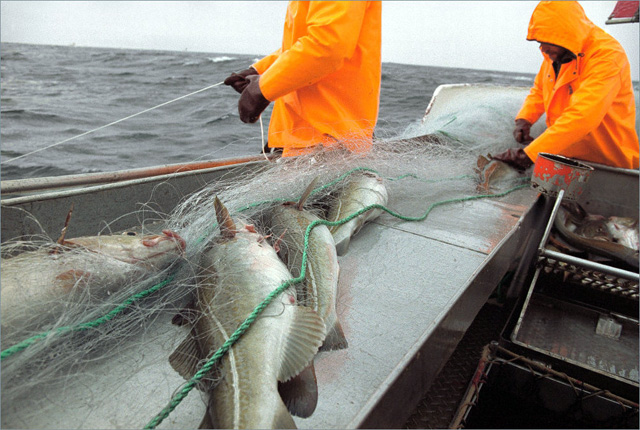The Northeast Arctic cod is the largest stock of cod in the world. There has been an increase in the catches made in Norwegian waters, with volumes now exceeding those of a few years ago.
The majority of the stock of Northeast Arctic cod is found in the Barents Sea, on the warm side of the Polar Front. When it comes to breeding time, migration starts towards the Norwegian coast in December and January. The main spawning areas are Lofoten and Vesterålen, but spawning also takes place at several places along the coast from Sunnmøre in the south to Finnmark in the north. The eggs are spawned in February-April. Eggs and larvae are then carried with the current into the Barents Sea.
Large catches
The renowned Lofoten fishing season for Northeast Arctic spawning cod (skrei) is one of our fisheries which is the most steeped in tradition. This activity dates back as far as the history of the area and the start of oral accounts being passed down. Lofoten is specifically the area, along with Vesterålen, which is clearly way ahead in terms of catch volume of Northeast Arctic spawning cod. Since 2007 the volume of Northeast Arctic cod in Lofoten has doubled from 30,798 tonnes to 60,608 tonnes in 2013. During the same period, the catches in Vesterålen have more than doubled from 16,825 tonnes in 2007 to 40,495 tonnes in 2013.
An increase has also been seen in the catch volume from fishing for Northeast Arctic spawning cod near Vikna, on the border between Nord-Trøndelag and Nordland, and on the coast of Sunnmøre and Romsdal. But both these fisheries are far smaller than those in Vesterålen and Lofoten.
Overall, a record quota has been achieved for Northeast Arctic cod in 2013. It amounts to a full 1 million tonnes. This is broken down as 43% for Norway and Russia respectively and 14% for third-party countries (EU, Iceland and Greenland).
The large vessels in the sea fishing fleet, such as trawlers, longliners and gillnetters, mainly fish for Northeast Arctic cod in the Barents Sea in the summer and autumn. On the other hand, fishing for spawning cod in the winter and spring along the coast is mainly done by the smaller vessels in the coastal fishing fleet.
Drop in value
Even though the catch volume of Northeast Arctic spawning cod has risen, the catch’s value has not increased accordingly. In fact, the catch’s value has decreased in 2013. Even though roughly twice as many Northeast Arctic cod were caught in Vesterålen, Lofoten and elsewhere in Nordland in 2013 than in 2008, the catch’s value is lower. In 2008 the value of the catches in these three areas amounted to NOK 835,428,300. The corresponding figure in 2013 was NOK 779,818,834.
Difference between Northeast Arctic cod and coastal cod
The Northeast Arctic cod is a predatory fish of up to 169 cm in length and 55 kg in weight, and mainly a demersal fish. However, in the Barents Sea it can also be present in the pelagic water masses during some parts of the year. Young cod live mainly on zooplankton, while fish and benthic creatures are the main food for older cod.
The stocks of Northeast Arctic cod are in a good state and were estimated by the Institute of Marine Research at 2.5 million tonnes in 2010. This cod stock is genetically different to the coastal cod, which are smaller, mature more quickly and spend their whole life in coastal waters. The stock of coastal cod is low. This is why fishing for coastal cod is subject to tight restrictions.
To prevent overfishing of the local coastal cod when fishing for spawning cod migrating from the Barents Sea, the Directorate of Fisheries takes samples of the cod caught during test fishing.
“The problem in Lofoten is that coastal cod and Northeast Arctic cod intermingle. This is why the Directorate of Fisheries takes samples of fish to establish whether the fish are coastal cod or skrei. If the samples indicate that around 90% are skrei in closed areas such as Henningsværboksen, we will make the area accessible for fishing,” says Olav Lekve, Head of communications at the Directorate of Fisheries.
In addition to the Northeast Arctic cod stocks in the Barents Sea, there are similar marine cod stocks around Iceland and the Faroes, in the Baltic, the North Sea, the Irish Sea, west of Scotland and in the areas around Georges Bank and Newfoundland in the Northwest Atlantic. There are also local coastal cod stocks not only along the coasts of Norway, but also off South Greenland and Canada.
Key facts: Breeding habits of the Northeast Arctic cod.
Fact sheet: Northeast Arctic cod.
By Kjetil S. Grønnestad.
